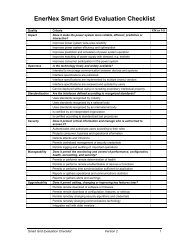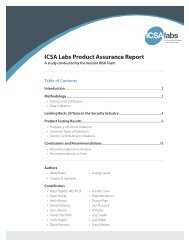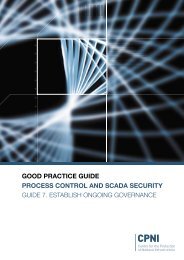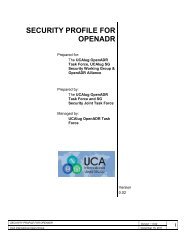Security Profile for Advanced Metering Infrastructure - Open Smart ...
Security Profile for Advanced Metering Infrastructure - Open Smart ...
Security Profile for Advanced Metering Infrastructure - Open Smart ...
You also want an ePaper? Increase the reach of your titles
YUMPU automatically turns print PDFs into web optimized ePapers that Google loves.
Figure 1 shows one of the scenarios as an example. From diagrams of this kind, we extracted<br />
• Components: each swim lane depicts a different entity involved in the business flow<br />
captured in the scenario's activity diagram. Some components represent system<br />
components, while others represent human actors. For our purposes, we restricted our<br />
attention to system components. Additionally, some components were deemed outside<br />
the scope of the AMI profile.<br />
• Communication: arrows between nodes often represent some communication of<br />
in<strong>for</strong>mation or control signals between components. Other times, arrows simply represent<br />
the sequence of activities. Some interpretation was necessary. The key in<strong>for</strong>mation<br />
extracted at this point was the nature of in<strong>for</strong>mation and control exchanged between<br />
components.<br />
Some inconsistencies and oversights were encountered in analyzing the use cases and scenarios.<br />
For example, in scenario 9 of use case B1, a meter is shown communicating with the MDMS<br />
without going through a Head End. This was inconsistent with many other scenarios, and<br />
assumed to be an oversight. Such corrections were made in several places to arrive at a<br />
consistent logical architecture.<br />
4.2 Logical architecture<br />
A logical architectural view depicts logical components and their interactions. By logical<br />
components, we refer to conceptual elements defined by common functionality. A logical<br />
architectural view does not attempt to capture deployment in<strong>for</strong>mation, such as allocation of<br />
functionality to hosts or network segments. Nor does it attempt to capture all terminology and<br />
physical configurations represented by different products.<br />
The logical architectural components have only the meaning defined in this document,<br />
regardless of how some other party may define the same terms.<br />
As such, any product implementing the function of a logical component, shall satisfy all security<br />
requirements identified in Section 5 that apply to that component—regardless of whether the<br />
product uses that component's name or whether it implements the functions of multiple<br />
components. Products that implement the functions of multiple components shall satisfy all<br />
security requirements of each component whose functions it implements.<br />
<strong>Security</strong> <strong>Profile</strong> <strong>for</strong> <strong>Advanced</strong> <strong>Metering</strong> <strong>Infrastructure</strong> Version 1.0<br />
UtiliSec Working Group (UCAIug) December 10, 2009<br />
9









